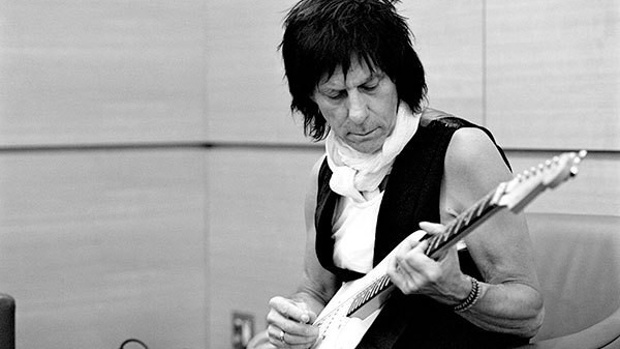Jeff Beck: 10 of the Guitar Heroes Finest Musical Moments
- Publish Date
- Thursday, 12 January 2023, 3:17PM

Jeff Beck, who died suddenly at the age of 78, was among the first and last of rock music’s epic guitar heroes. He played according to his own rules, with styles as unpredictable as the diverse genres through which he jammed, flanged, strummed and rolled.
Capriciously innovative and unwilling to compromise — often to the detriment of having a single-minded career goal — Beck was one of Great Britain’s most noted musicians to come out of the psychedelic blues-based 1960s, an honor he shared with his fellow Yardbirds, Eric Clapton and Jimmy Page.
For all of his frenetic soloing prowess, however, Beck was, like Keith Richards, a rhythm guitar monster whose dedication to soul led him to create gorgeous licks for a young, pre-Faces Rod Stewart and alongside Stevie Wonder on the latter’s “Talking Book” classic. Along with these fellow legends, Beck famously played with David Bowie during his 1973 Ziggy Stardust at London’s Hammersmith Odeon and on Ozzy Osbourne’s latest album, 2022’s “Patient Number 9.”
From feedback-heavy rave-ups and fuzz-toned metallic blues, to swirling funk workouts and gently emotional jazz-fusion tracks, Jeff Beck’s diverse tones — usually played on his favored Fender Stratocaster — were as notoriously temperamental as his personality. Here are ten iconic moments from Beck’s career.
Jeff Beck, “Hi Ho Silver Lining”/ ”Beck’s Bolero” (1967)
For his debut solo single, the guitarist chose a marching rocker as his “A” side, and a mournful, complex, multi-chapter take on Ravel’s sensual suite as its “B” side featuring guest session players such as the Who’s Keith Moon, Rolling Stones associate Nicky Hopkins, and a pre-Led Zeppelin John Paul Jones. While its stammering drums and hammering piano provide a stark rhythmic base, Beck’s majestic guitar line slowly slithers through his “Bolero” like a snake.
Jeff Beck, “I Ain’t Superstitious” (1968)
Though credited to Beck alone, the “Truth” album featuring Willie Dixon’s “I Ain’t Superstitious,” also served as the introduction to the Jeff Beck Group – its vocalist Rod Stewart, bassist Ronnie Wood and drummer Micky Waller. It’s hard to tell who is more blowzily bluesy on this crunching metallic cut – a gruffly singing Stewart, or guitarist Beck whose wild, sensual wah-wah effects make for a slow, expressive conversation.
The Jeff Beck Group, “Situation” (1971)
Following his stint with Rod Stewart, Beck moved onto his next phase, a soul-inspired and jazzily fleet-fingered newer edition of the Jeff Beck Group featuring singer Bobby Tench, pianist Max Middleton, bassist Clive Chaman and drummer Cozy Powell. Beck moves from echo-heavy rockabilly licks (the sounds of his youth) to fluid, clarion squalls of sound.
Stevie Wonder, “Lookin’ for Another Pure Love” (1972)
To vibe with Stevie Wonder’s move into airy Fender Rhodes-based R&B and Moog-driven funk, the artist utilized the talents of Beck, whose work across the languid ballad jumps from crystal clear solos and speedily-devised clusters of harmony to what sounds like a Hawaiian slack key guitar. Brilliant and simple, this collaboration defined much of what would occur for both artists across the next decade.
Beck, Bogert & Appice, “Superstition” (1973)
The post-Cream power trio featured bassist Tim Bogert and drumming all-star Carmine Appice of Vanilla Fudge. Their finest moment: the dirty funk jam jive of “Superstition.” Written by Stevie Wonder during his “Talking Book” sessions with Beck, Bogert’s screamo-vocals and rough, grimy soloing from the guitarist could have made this a smash before Stevie’s hit, had the label not bungled its release.
Jeff Beck, “She’s a Woman” (1975)
Every lush track on “Blow by Blow” — Beck’s 1975 Top 10 smash — is a winner. From its rendition of Stevie Wonder songs such as “Thelonius,” to George Martin’s spacious production and opulent orchestral arrangements, to the spare backing of keyboardist Max Middleton, bassist Phil Chen and drummer Richard Bailey, the album is pop jazz-fusion perfection. Yet it is his twinkling twilight instrumental take on Lennon and McCartney’s “She’s a Woman” — complete with its galloping rhythms, breathy Talk Box and Beck’s ever-so-slightly sizzling guitar sound — that stands out.
Jeff Beck, “Star Cycle” (1980)
From the “There & Back” album, featuring his then-constant companion, keyboardist, sequencer and synth player Jan Hammer (along with drummer Simon Phillips and Bowie producer Ken Scott), “Star Cycle” is pop-prog at its slickest. Beck rises to the occasion with some crystal shattering highs, and this spiraling “Star Cycle” has been used to great effect in wrestling matches and the 1983 film “Risky Business.”
Kate Bush, “You’re the One” (1993)
Procol Harum-like art rock from Kate Bush might not seem like something that would attract Jeff Beck. Which is probably why he wound up doing the gig. Between her bluesy Fender Rhodes and Procol’s Gary Brooker on Hammond Organ, Beck can be heard playing some understatedly beautiful licks – that is, until he breaks out a razoring solo as the track fades to black. Simply gorgeous.
Jeff Beck and the Big Town Playboys, “Hold Me, Hug Me, Rock Me” (1993)
In dedication to his first musical hero, Gene Vincent’s Blue Caps — and Vincent’s early guitarist Cliff Gallup — Beck, British blues vocalist and pianist Mike Sanchez, and a fuming rockabilly crew present a hot-wired, echo-heavy rendition of “Hold Me, Hug Me, Rock Me.” Penned by Vincent and Sheriff Tex Davis, Beck’s licks are hallowed, brash and authentic, yet move with a wild brand of inspiration meets improvisation that extends beyond mere tribute.
Originally published by Variety.
Take your Radio, Podcasts and Music with you

